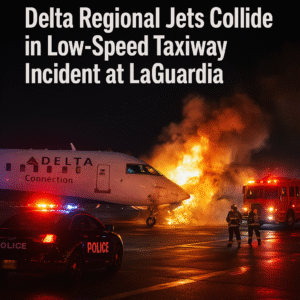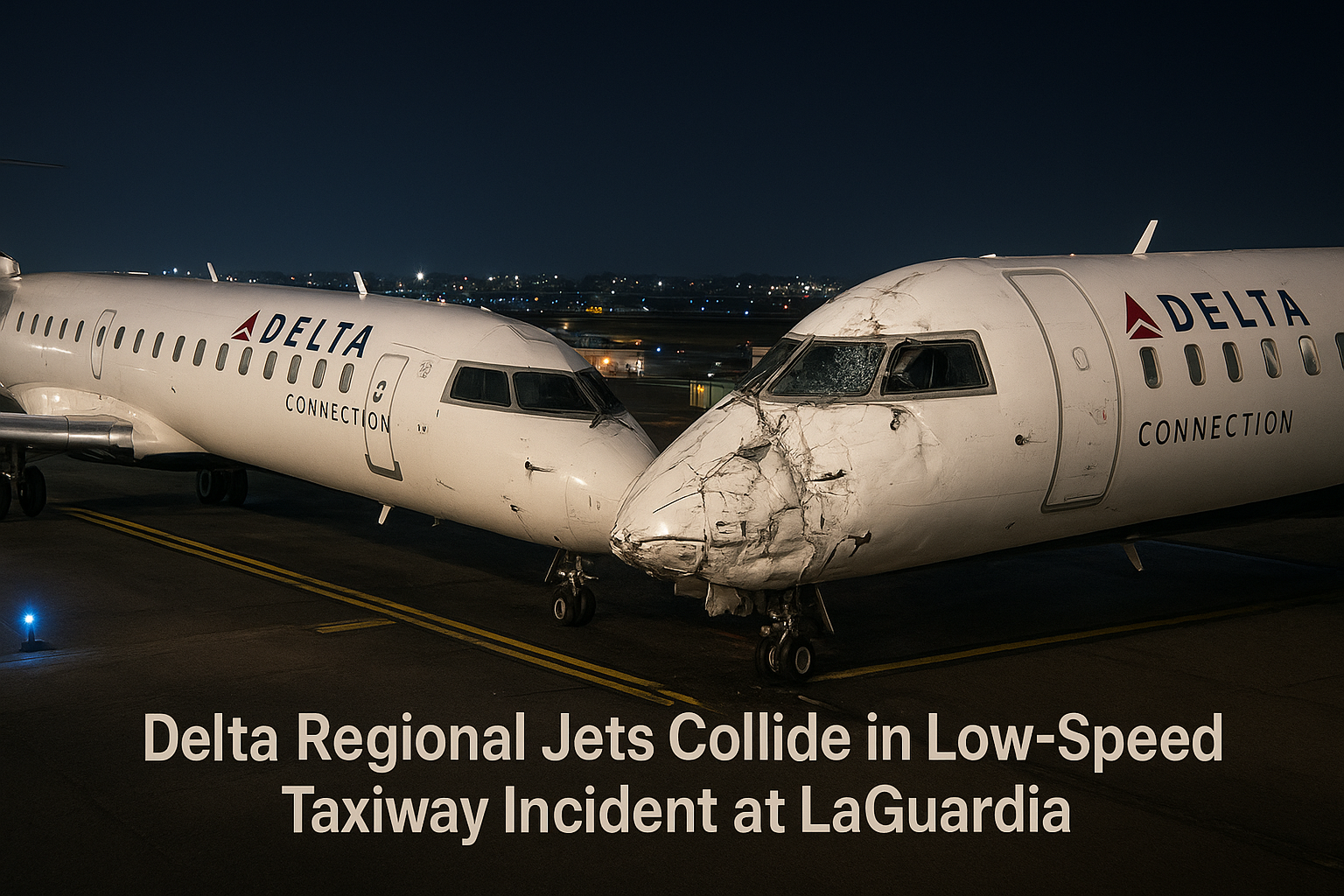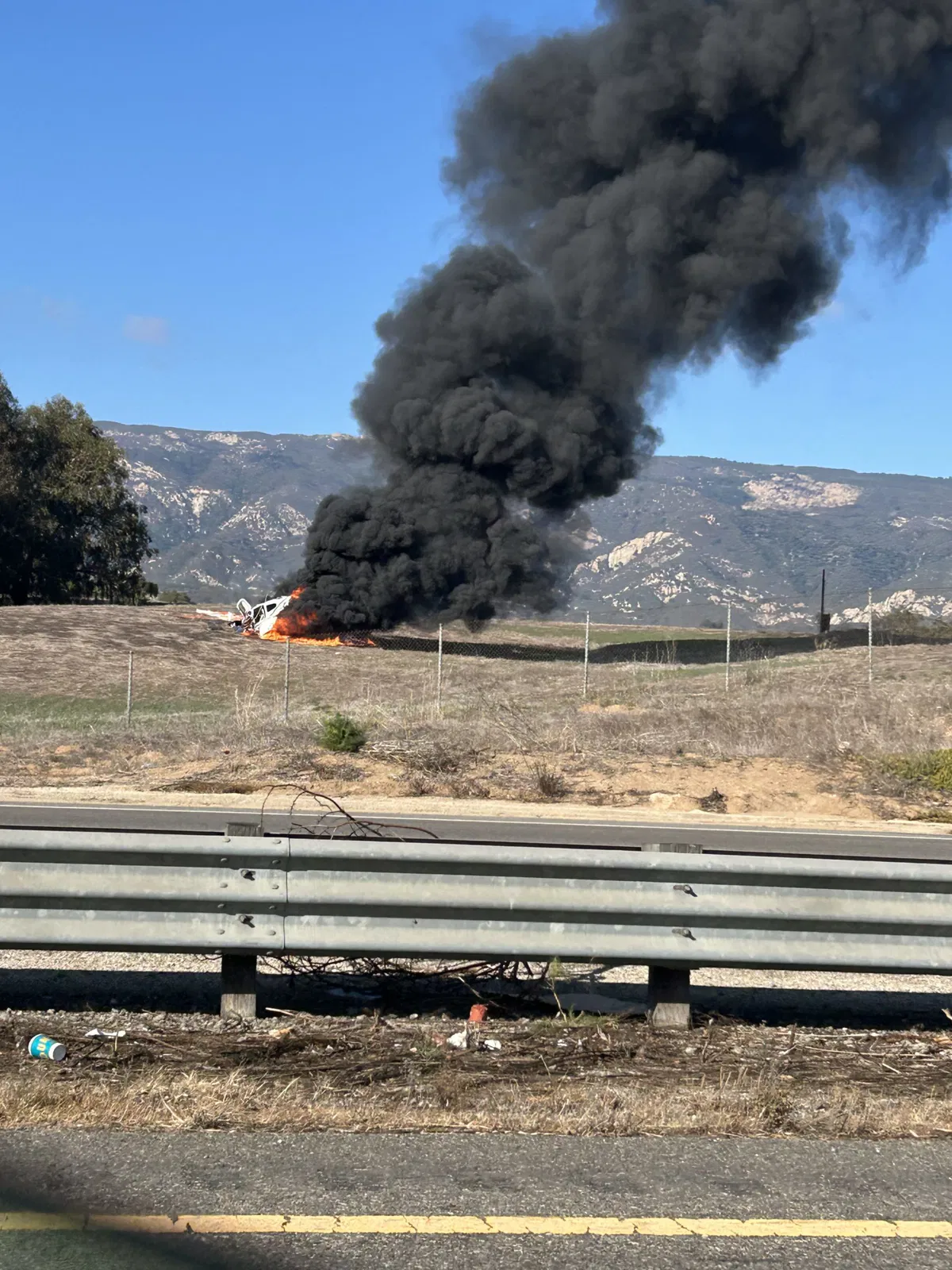#DeltaAirLines #LaGuardia #AviationSafety #AirTravel #FAA #NTSB #AviationNews
Low-Speed Collision: Two Delta Regional Jets Make Contact at LaGuardia Airport
Two Delta Air Lines regional jets collided on the taxiway at New York’s LaGuardia Airport Wednesday night in a low-speed incident that resulted in significant structural damage to both aircraft but fortunately caused only minor injuries. The collision occurred when the wing of one aircraft slammed into the cockpit windows of the other, creating a dramatic scene on the tarmac that required emergency response and resulted in dozens of passengers being evacuated onto the taxiway before being bused back to the terminal.
The incident, which occurred during routine ground operations at one of the nation’s busiest airports, highlights the ongoing challenges of aircraft ground safety despite numerous technological advances and procedural improvements implemented in recent years. While ground collisions remain relatively rare compared to the thousands of daily aircraft movements at major airports, each incident provides valuable lessons about the complex choreography required to safely manage aircraft traffic in congested terminal environments.
Incident Details and Description of the Impact
Aircraft Identification and Operator (Endeavor Air CRJ-900s)
The incident occurred at approximately 9:56 PM/10:00 PM Eastern Time on October 2, 2025, during the evening operational period when LaGuardia experiences significant aircraft movements as airlines complete their daily flight schedules. The timing of the collision during hours of darkness may have contributed to visibility challenges that can complicate ground operations even with modern lighting systems and taxiway markings.
Both aircraft involved in the “low-speed collision” were CRJ-900 regional jets operated by regional carrier Endeavor Air, a wholly-owned subsidiary of Delta Air Lines that operates Delta Connection flights throughout North America. The CRJ-900, manufactured by Bombardier (now owned by Mitsubishi Heavy Industries), represents one of the most common regional jet types in North American service, with capacity for approximately 76-90 passengers depending on configuration.
Flight 5047 had just arrived from Charlotte, North Carolina, when the wing of Flight 5155, preparing to depart to Roanoke, Virginia, collided with the nose of their aircraft. This sequence of events indicates that the collision occurred during the transition period when one aircraft was completing its arrival procedures while another was beginning its departure sequence, a particularly complex phase of ground operations requiring precise coordination between pilots, ground controllers, and ramp personnel.
The Contact: Wing Strikes Nose and Cockpit Windscreen
Endeavor Flight 5155 was taxiing for departure when its wing made contact with the fuselage of Endeavor Flight 5047 as it was taxiing to its gate after arriving, demonstrating how even low-speed ground movements can result in significant damage when aircraft paths intersect unexpectedly. The collision dynamics suggest that Flight 5155’s crew may not have been fully aware of Flight 5047’s position or may have misjudged the clearance required for safe passage.
The right wing of the departing aircraft (Flight 5155) struck the nose and cockpit windscreen of the arriving aircraft (Flight 5047), causing substantial structural damage to both aircraft that will require extensive inspection and repair before they can return to service. The impact location on Flight 5047’s nose section is particularly critical, as the cockpit area houses essential avionics, flight controls, and the structural integrity necessary for safe pressurization during flight.
The Flight 5047 pilot reported cockpit windscreen damage during radio communications with air traffic control, providing immediate notification that allowed controllers to coordinate appropriate emergency response and ensure that other aircraft movements were adjusted to accommodate the incident. This professional communication under stressful circumstances exemplifies the training and protocols that help manage aviation emergencies effectively even when unexpected events occur.
The collision mechanics suggest that the wingspan of the departing CRJ-900 exceeded the clearance available as it maneuvered past the arriving aircraft, potentially indicating issues with taxiway spacing, pilot situational awareness, or ground controller instructions regarding aircraft positioning and movement sequencing.

Human Impact and Passenger Testimony
One Flight Attendant Injured, No Passengers Harmed
While no passengers were injured, a flight attendant sustained non-life-threatening injuries and was transported to the hospital as a precaution, representing the only casualty from an incident that could have resulted in far more serious consequences if the collision had occurred at higher speeds or involved different aircraft areas. The flight attendant’s injury, reported as a knee injury in some accounts, likely occurred during the sudden impact when the collision forces caused unexpected aircraft movement.
The injured crew member was taken to a local hospital for evaluation and treatment, with the injury characterized as minor despite requiring medical attention. The precautionary hospital transport reflects standard protocols for aviation incidents where any reported injury receives thorough medical assessment regardless of initial severity perceptions.
No injuries were reported among the 85 total passengers (57 on Flight 5047 and 28 on Flight 5155), a fortunate outcome that reflects both the low-speed nature of the collision and the robust safety standards that govern aircraft structural design. The passenger load on both flights was relatively light compared to the aircraft’s maximum capacity, potentially contributing to the evacuation efficiency and the absence of passenger injuries during the incident response.
The Moment of Impact: A “Super-Violent” Shock During Taxiing
Passengers described the impact using terms that convey the sudden and unexpected nature of the collision despite its low speed. One passenger characterized the collision as “absolutely smashed,” while another described it as “super jarring,” emphasizing the violent sensation experienced inside the aircraft when the wing struck the nose section. These descriptions reflect how even low-speed collisions can generate significant forces and noise that alarm passengers unfamiliar with the structural strength of modern aircraft.
A passenger reported that the aircraft “stopped, shook, and jumped to the right” immediately after landing, providing a vivid description of the collision dynamics from inside the cabin. This account suggests that the impact generated sufficient force to alter the aircraft’s position on the taxiway, potentially moving it laterally or causing it to rock on its landing gear in ways that would have been frightening for passengers who initially might not have understood what had occurred.
The passenger testimonies underscore the psychological impact of aviation incidents even when physical injuries are minimal or nonexistent. The unexpected nature of ground collisions, combined with passengers’ general lack of information about what’s happening outside the aircraft, can create anxiety and concern that persists even after it becomes clear that the situation is under control and no serious danger exists.
Airline Response and Investigation Launch
Passenger Management: Bus Evacuation and Logistical Assistance
Photos and videos from the scene showed flashing emergency lights, passengers being escorted off the jets, and the crumpled wreckage of one plane’s nose. Delta confirmed that all 85 passengers were taken off the damaged planes and bused back to Terminal C, demonstrating the coordinated emergency response that modern airports can deploy when incidents occur. The decision to evacuate passengers onto the taxiway rather than through jet bridges reflects the aircraft positions following the collision and the need to expedite passenger evacuation from damaged aircraft.
Delta provided meals, beverages, and hotel rooms for affected passengers, along with rebooking on alternative flights to their destinations. This comprehensive passenger care response exceeds minimum regulatory requirements and reflects Delta’s commitment to maintaining customer satisfaction even during disrupted operations. The provision of hotel accommodations was particularly important given the late-night timing of the incident, which would have made immediate rebooking challenging for many passengers.
Delta spokesperson Morgan Durrant said: “Delta teams at our New York-LaGuardia hub are working to ensure our customers are taken care of after two Delta Connection aircraft operated by Endeavor Air were involved in a low-speed collision during taxi”. The airline issued formal apologies to customers for the experience, acknowledging the disruption and inconvenience while emphasizing their commitment to safety and customer care during the recovery process.
The passenger assistance response included dedicated Delta personnel who provided real-time updates, answered questions, and addressed individual passenger concerns regarding connections, accommodations, and rebooking options. This personalized attention helps mitigate passenger frustration and maintains brand loyalty even when operational disruptions occur through circumstances beyond the airline’s immediate control.
Collaboration with FAA and NTSB: Delta’s Commitment
Delta will work with all relevant authorities including the FAA (Federal Aviation Administration) and NTSB (National Transportation Safety Board) to examine what happened, emphasizing that safety remains the top priority. This cooperation with federal investigators is both legally required and operationally necessary to determine the collision’s root causes and implement corrective measures that prevent similar incidents from occurring in the future.
The incident occurred at the beginning of a government shutdown, though it remained unclear whether this affected staffing levels at LaGuardia at the time. Government shutdowns can impact FAA operations including air traffic control staffing and safety inspector availability, though essential personnel typically continue working even during funding lapses. The investigation will need to assess whether any shutdown-related factors contributed to the incident, though initial reports suggest this was unlikely given that essential air traffic control services remain operational during shutdowns.
The NTSB investigation will examine multiple factors including pilot actions and communications, air traffic control instructions and clearances, airport lighting and marking conditions, crew fatigue and workload, and aircraft mechanical systems to develop a comprehensive understanding of how this collision occurred. This thorough investigative approach ensures that lessons learned from the incident are properly documented and shared throughout the aviation industry to enhance safety standards.
Airport Operations Unaffected
The Port Authority of New York and New Jersey confirmed that the incident had no impact on overall LaGuardia Airport operations, indicating that the collision’s location and the efficient emergency response allowed normal airport operations to continue with minimal disruption. This operational resilience reflects the airport’s ability to manage incidents while maintaining service levels for the thousands of passengers who depend on scheduled flight operations.
The limited operational impact resulted from the collision occurring on a taxiway rather than a runway, allowing aircraft arrivals and departures to continue on LaGuardia’s active runways while emergency crews managed the incident scene. Modern airports maintain contingency plans for various incident scenarios, enabling them to quickly isolate affected areas while rerouting aircraft movements to maintain operational flow.
The Port Authority’s rapid assessment and public communication regarding operational status helped airlines and passengers understand that the incident, while serious for those directly involved, did not require broader flight cancellations or significant delays. This transparent communication represents best practices in airport crisis management and helps maintain public confidence in aviation safety systems.




